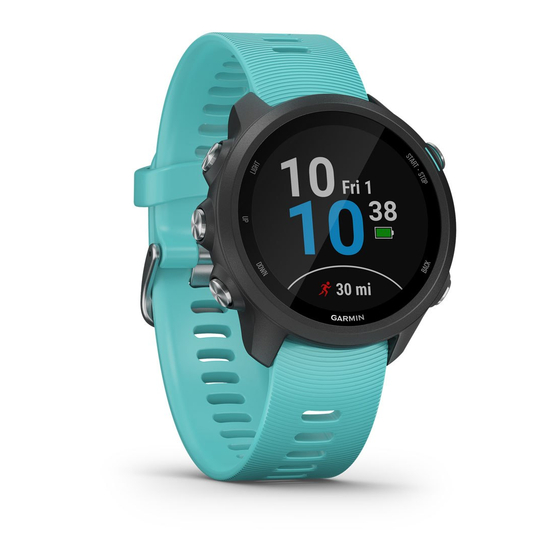Garmin FORERUNNER 245 Benutzerhandbuch - Seite 17
Blättern Sie online oder laden Sie pdf Benutzerhandbuch für Siehe Garmin FORERUNNER 245 herunter. Garmin FORERUNNER 245 40 Seiten.

While developing and testing running dynamics, the Garmin team found correlations between injuries and greater imbalances with
certain runners. For many runners, ground contact time balance tends to deviate further from 50–50 when running up or down hills.
Most running coaches agree that a symmetrical running form is good. Elite runners tend to have quick and balanced strides.
You can watch the color gauge or data field during your run or view the summary on your Garmin Connect account after your run.
As with the other running dynamics data, ground contact time balance is a quantitative measurement to help you learn about your
running form.
Vertical Oscillation and Vertical Ratio Data
The data ranges for vertical oscillation and vertical ratio are slightly different depending on the sensor and whether it is positioned at
the chest (HRM-Tri or HRM-Run accessories) or at the waist (Running Dynamics Pod accessory).
Color Zone Percentile in Zone Vertical Oscillation Range at
Purple
>95
Blue
70–95
Green
30–69
Orange 5–29
Red
<5
Tips for Missing Running Dynamics Data
If running dynamics data does not appear, you can try these
tips.
• Make sure you have a running dynamics accessory, such as
the HRM-Run accessory.
Accessories with running dynamics have
module.
• Pair the running dynamics accessory with your Forerunner
device again, according to the instructions.
• If the running dynamics data display shows only zeros, make
sure the accessory is worn right-side up.
NOTE: Ground contact time and balance appears only while
running. It is not calculated while walking.
Performance Measurements
These performance measurements are estimates that can help
you track and understand your training activities and race
performances. The measurements require a few activities using
wrist-based heart rate or a compatible chest heart rate monitor.
These estimates are provided and supported by Firstbeat. For
more information, go to www.garmin.com/runningscience.
NOTE: The estimates may seem inaccurate at first. The device
requires you to complete a few activities to learn about your
performance.
Training status: Training status shows you how your training
affects your fitness and performance. Your training status is
based on changes to your training load and VO2 max. over
an extended time period.
VO2 max.: VO2 max. is the maximum volume of oxygen (in
milliliters) you can consume per minute per kilogram of body
weight at your maximum performance. Your device adjusts
the VO2 max. values for heat and altitude, such as when you
are acclimating to high heat environments or high altitude.
Recovery time: The recovery time displays how much time
remains before you are fully recovered and ready for the next
hard workout.
Training load: Training load is the sum of your excess post-
exercise oxygen consumption (EPOC) over the last 7 days.
Heart Rate Features
Chest
<6.4 cm
6.4–8.1 cm
8.2–9.7 cm
9.8–11.5 cm
>11.5 cm
on the front of the
Vertical Oscillation Range at
Waist
<6.8 cm
6.8–8.9 cm
9.0–10.9 cm
11.0–13.0 cm
>13.0 cm
EPOC is an estimate of how much energy it takes for your
body to recover after exercise.
Predicted race times: Your device uses the your training
history, your VO2 max. estimate, and published data sources
to provide a target race time based on your current state of
fitness. This projection also presumes you have completed
the proper training for the race.
Performance condition: Your performance condition is a real-
time assessment after 6 to 20 minutes of activity. It can be
added as a data field so you can view your performance
condition during the rest of your activity. It compares your
real-time condition to your average fitness level.
Turning Off Performance Notifications
Performance notifications are turned on by default. Some
performance notifications are alerts that appear upon completion
of your activity. Some performance notifications appear during
an activity or when you achieve a new performance
measurement, such as a new VO2 max. estimate.
1
From the watch face, hold UP.
2
Select Settings > Physiological Metrics > Performance
Notifications.
3
Select an option.
Detecting Your Heart Rate Automatically
The Auto Detection feature is turned on by default. The device
can automatically detect your maximum heart rate during an
activity.
NOTE: The device detects a maximum heart rate only when
your heart rate is higher than the value set in your user profile.
1
From the watch face, hold UP.
2
Select Settings > Physiological Metrics > Auto Detection
> Max. HR.
NOTE: You can manually set your maximum heart rate in
your user profile
Syncing Activities and Performance Measurements
You can sync activities, personal records, and performance
measurements from other Garmin devices to your Forerunner
device using your Garmin Connect account. This allows your
device to more accurately reflect your training status and fitness.
For example, you can record a ride with an Edge device, and
view your activity details and overall training load on your
Forerunner device.
1
From the watch face, hold UP.
2
Select Settings > Physiological Metrics > TrueUp.
When you sync your device with your smartphone, recent
activities, personal records, and performance measurements
Vertical Ratio at Chest Vertical Ratio at Waist
<6.1%
<6.5%
6.1–7.4%
6.5–8.3%
7.5–8.6%
8.4–10.0%
8.7–10.1%
10.1–11.9%
>10.1%
>11.9%
(Setting Your Heart Rate Zones, page
7).
13
